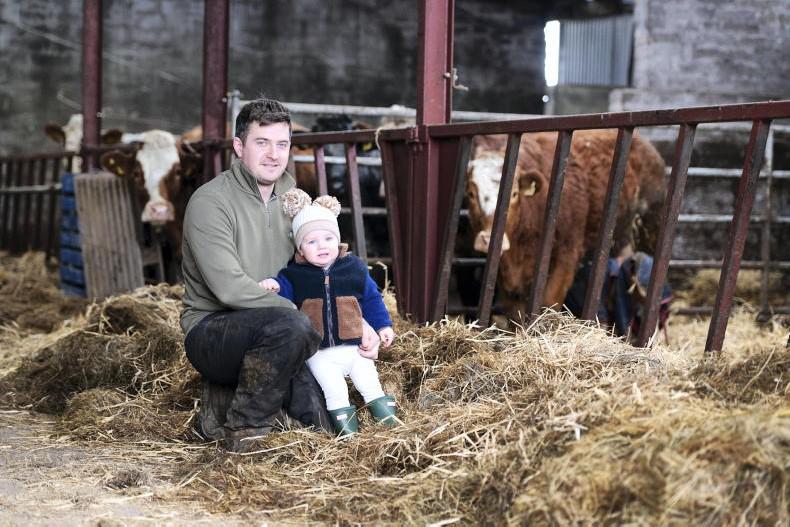Tullamore Farm was set up in 2017 when the lease of the 200-acre farm was signed by the Grogan family and Tullamore Farm Ltd, the company that operates the farm.
The purpose of the farm is to demonstrate to drystock farmers the potential there is inside the farm gate to improve profitability.
This can be achieved using a variety of technologies such as grass measuring, budgeting, getting soil fertility right, using the right genetics, good herd health planning and time management.
The farm also acts as a hub for our livestock team to generate videos and unique content for publication in the Irish Farmers Journal and our website.
Shaun Diver is the farm manager and he is tasked with running the farm on a daily basis, with support from the Irish Farmers Journal livestock team.
The lease
The lease is a standard IFA master lease between the Grogan family and Tullamore Farm Ltd.
The rental cost is €140/ac, with the Grogan family holding on to the single farm payment.
Other livestock-related payments, such as the ANC payment, ewe payment, BDGP, BEEP and BEAM payments will remain with Tullamore Farm Ltd.
There is a 60:40 split between Tullamore Farm Ltd and the Grogan family on all capital expenditure incurred on the farm.
Finance
ifac has full responsibility for generating farm accounts for the farm.
Making a profit on the farm is a huge challenge without a single farm payment, while also paying full land rent and full labour costs.
The farm has also borrowed money to fund the project and interest is being paid back on this loan.
There is no scope within the farm system to pay capital repayments and stock and machinery will be sold at the end of the project to pay back the capital on the loan.
The system
Teagasc research would indicate that high grass utilisation, high animal performance and optimal stocking rates are all ingredients for a profitable beef farm.
The Tullamore Farm system is built around putting Teagasc research into practice, which involves growing and utilising the maximum amount of grass on the farm.
Soil fertility and grazing infrastructure were two of the first items to address on the farm, followed by reseeding with perennial ryegrass and clover swards.
The suckler system is built around a high-replacement index cow, irrespective of breed. The herd is spring-calving in February, March and April. The focus of the breeding programme is to:
Breed high-quality, high-replacement index, high-health status heifers suitable for the suckler herd.Produce high-quality male progeny that will finish as bulls under 16 months.Since its inception in 2017, the farm has progressed to use more and more AI, with over 80% AI used during the 2019 breeding season.Mixed grazing
Teagasc research has shown that mixed grazing of cattle and sheep provides significant benefits, with a lift in animal performance of up to 10% and scope to increase overall farm stocking rate by 7% without having a significant effect on input requirements.
Sheep sales from June onwards have also been a welcome boost to cashflow.
The sheep system has been the highlight of the project so far and there are plans in place to increase ewe numbers.
Progress
It’s been a roller coaster two and a half years on Tullamore Farm. The farm has witnessed some high points such as calf weight gains, grass growth and calving season successes.
It has also had its fair share of problems including infertile bulls, tetany, storm Emma and dealing with the drought conditions of summer 2018.
There have been lessons learned for everybody from the project so far and we will continue to report everything that happens on the farm, good and bad, in the years to come.
Tullamore Farm was set up in 2017 when the lease of the 200-acre farm was signed by the Grogan family and Tullamore Farm Ltd, the company that operates the farm.
The purpose of the farm is to demonstrate to drystock farmers the potential there is inside the farm gate to improve profitability.
This can be achieved using a variety of technologies such as grass measuring, budgeting, getting soil fertility right, using the right genetics, good herd health planning and time management.
The farm also acts as a hub for our livestock team to generate videos and unique content for publication in the Irish Farmers Journal and our website.
Shaun Diver is the farm manager and he is tasked with running the farm on a daily basis, with support from the Irish Farmers Journal livestock team.
The lease
The lease is a standard IFA master lease between the Grogan family and Tullamore Farm Ltd.
The rental cost is €140/ac, with the Grogan family holding on to the single farm payment.
Other livestock-related payments, such as the ANC payment, ewe payment, BDGP, BEEP and BEAM payments will remain with Tullamore Farm Ltd.
There is a 60:40 split between Tullamore Farm Ltd and the Grogan family on all capital expenditure incurred on the farm.
Finance
ifac has full responsibility for generating farm accounts for the farm.
Making a profit on the farm is a huge challenge without a single farm payment, while also paying full land rent and full labour costs.
The farm has also borrowed money to fund the project and interest is being paid back on this loan.
There is no scope within the farm system to pay capital repayments and stock and machinery will be sold at the end of the project to pay back the capital on the loan.
The system
Teagasc research would indicate that high grass utilisation, high animal performance and optimal stocking rates are all ingredients for a profitable beef farm.
The Tullamore Farm system is built around putting Teagasc research into practice, which involves growing and utilising the maximum amount of grass on the farm.
Soil fertility and grazing infrastructure were two of the first items to address on the farm, followed by reseeding with perennial ryegrass and clover swards.
The suckler system is built around a high-replacement index cow, irrespective of breed. The herd is spring-calving in February, March and April. The focus of the breeding programme is to:
Breed high-quality, high-replacement index, high-health status heifers suitable for the suckler herd.Produce high-quality male progeny that will finish as bulls under 16 months.Since its inception in 2017, the farm has progressed to use more and more AI, with over 80% AI used during the 2019 breeding season.Mixed grazing
Teagasc research has shown that mixed grazing of cattle and sheep provides significant benefits, with a lift in animal performance of up to 10% and scope to increase overall farm stocking rate by 7% without having a significant effect on input requirements.
Sheep sales from June onwards have also been a welcome boost to cashflow.
The sheep system has been the highlight of the project so far and there are plans in place to increase ewe numbers.
Progress
It’s been a roller coaster two and a half years on Tullamore Farm. The farm has witnessed some high points such as calf weight gains, grass growth and calving season successes.
It has also had its fair share of problems including infertile bulls, tetany, storm Emma and dealing with the drought conditions of summer 2018.
There have been lessons learned for everybody from the project so far and we will continue to report everything that happens on the farm, good and bad, in the years to come.









SHARING OPTIONS